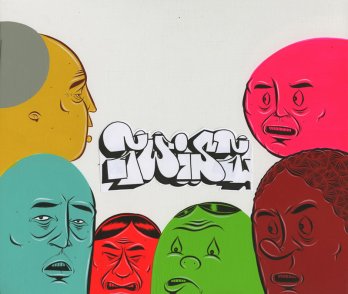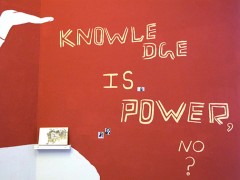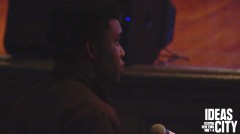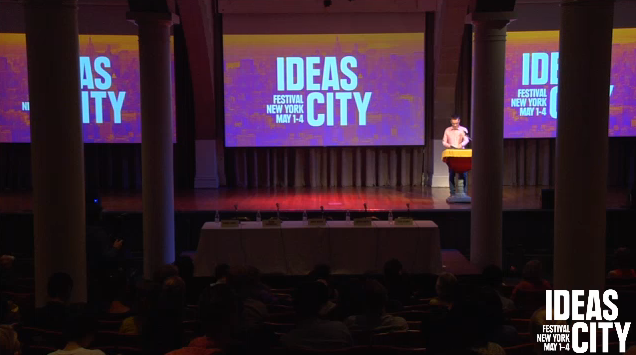“’Youth,’ according to Oscar Wilde, ‘is wasted on the young.’ While this old adage remains today, it is this panel’s contention that, with proper nurture, youth has the potential to be a powerful force. Youth is, after all, a vast global neighborhood replete with its own government, social networks, and modes of learning. Youth’s problems emerge from the unstoppable shadow of the world it enters. Youth as Untapped Capital is the subject of this panel, where mentors and innovators discuss the incredible capacity of today’s youth as innovators for change.” — from IDEAS CITY, a four day exploration of the future of cities, held in Lower Manhattan from May 1 – 4, 2013, organized by the New Museum.
CITY ATLAS was glad to participate in the IDEAS CITY StreetFest this year with our Share Your City tattoo project. We also took the opportunity to attend several of the conference panels held at Cooper Union’s Great Hall, which we will cover in these pages, beginning today with the IDEAS CITY panel on youth at a time of rapid transformation.
Dennis Scholl of the Knight Foundation moderated the panel, which explored how organizations can access the energy and capabilities of young people in cities everywhere. Four panelists were invited to present their work: Naomi Hirabayashi of DoSomething.org, visual artist Barry McGee, visual artist Carlos Motta, and Ellin O’Leary of Youth Radio.
DoSomething.org is a platform that allows young people to participate in social activism without needing “money, a car, or an adult”. There are pre-defined campaigns with action items that people can participate in, or people can create their own. Naomi talked about the great success of their programs in mobilizing youth to act on diverse issues, from homelessness to texting while driving. She showed how DoSomething.org taps into the unique and advantageous position young people have over an adult authority figure when educating other young people.

Barry McGee’s interests are in “youthful activities and things that are slightly agitating”, mainly in the form of street art. He sees graffiti as a venue for self-expression in public spaces, contrasting it with large print advertisements: “A tag isn’t selling anything but yourself…[just] your beautiful name.” He also talked about how kids in San Francisco are subverting authority by tagging using the free anti-graffiti paint intended for painting over graffiti. McGee showed us how youth are persistent in making their mark “in the landscape of things”.

Carlos Motta’s presentation focused on his documentation of queer youth activism, in particular, activism that lies outside of mainstream politics. The national focus on gay rights mainly involves the institutions of marriage, military, and the prison industrial complex. Motta is interested in radical activism that works outside of this space. In his research, Motta has interviewed Queerocracy, a group that has worked on AIDS funding and criminalization based on HIV status, and Felipe Baeza, an undocumented U.S. resident and queer activist, who focuses on the rights of undocumented residents, especially their right to an education.
Ellin O’Leary spoke about her organization, Youth Radio, which gives low-income youth the resources to produce radio shows, videos, music, and other forms of digital media. This allows young people to share their experiences with a wider audience, via a channel they have complete control over. She also talked about the integration of Youth Radio into the Oakland community. Young participants at the organization helped transform the exterior of the building into a memorial to Oscar Grant. They also helped start Art Murmur, a night street festival centered on the arts. Allowing the youth to start their own initiatives at the organization has helped the program to be accepted by the community.
Dennis Scholl started off the panel discussion by asking how we can get youth ‘onto the board.’ At this statement, a man jumped up from the audience and launched into a spoken word performance about the importance of education and the negative impact that will be caused by budget cuts for many school systems. He also remarked on the fact that many important life lessons are missing from the school curriculum; for example, money and physical appearance aren’t everything. The panelists looked on, surprised and interested. At the conclusion of the performance, Dennis revealed that we had experienced a “Random Act of Culture number 1,245”. The performer was Jamarr Hall, a member of the Philly Youth Poetry Movement, and Dennis had invited him to the panel.
During the subsequent Q&A, the speakers touched on the themes of empowering youth, self-organizing, and the digital revolution. Speakers commented on the importance of giving youth choices and options as a way to empower them. Carlos mentioned youth activists in South Korea, who were able to self-organize and find safe places to meet. The speakers also discussed the digital revolution and the benefits and challenges that come with any change. Social media and SMS gives youth a way to self-organize and communicate quickly but at the same time, there are some groups that are marginalized on these platforms.

The first audience member that spoke gave a critique rather than a question. He challenged the entire premise of the panel, remarking that youth did not want to be on “the board” with the panelists, and they were more interested in making their own board. He told the panel that instead of trying to solve society’s problems, “you need to focus on the obstacles you present…We’re worried about you. We don’t trust you.” He also pointed out that there were very few young people at the panel.
The panelists did not reply.
More questions followed from the audience, from educators and adults who work with young, low-income people, about how to allow kids to be freer and unrestricted and how to get low-income students interested in participating in community service.
But none of the ensuing discussion was as interesting as the challenge from that first audience member. The interaction left me thinking, what was the purpose of a panel about youth put on by adults for adults? Are people co-opting the talents and enthusiasm of young people for their own purposes or empowering them? Teens today face a world undergoing rapid change, and young people’s opinions on critical issues don’t yet match up with the scale of the issues themselves. Every step that helps young people engage more fully cannot be valued highly enough, and maybe they should be making their own board.
